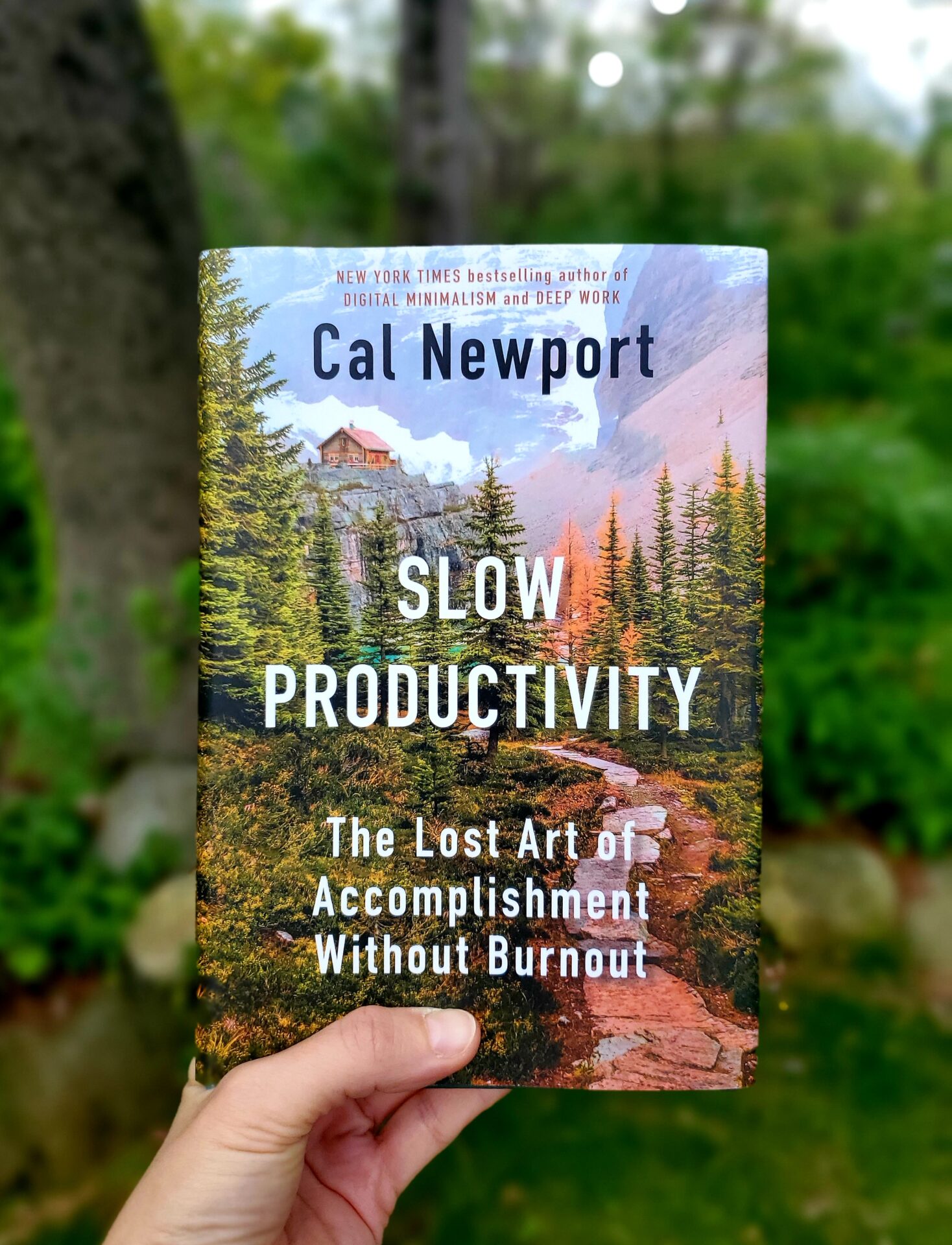Slow Productivity: The Lost Art of Accomplishment Without Burnout is a book that 20-Something CJ wouldn’t have looked twice at.
Let’s fast forward (quite) a few years to, well, now. CJ’s in her early 40s (and apparently speaking in third person). She has a great career and several side hustles that she loves.
And she’s exhausted from trying to fit everything in.
So, you better believe she/I clicked Order on bookshop.org and tracked the incoming copy of Slow Productivity like kids track Santa on Christmas Eve.
What’s Slow Productivity about?
Slow Productivity: The Lost Art of Accomplishment Without Burnout is about implementing different techniques and strategies into your workflow to decrease stress, increase work-life balance, and increase product quality levels over long periods of time.
In layman’s terms: Worker smarter, not harder. Live a happier life while still getting more done.
In our current go-go-go society, knowledge workers are burning out like crazy. Author Cal Newport’s “slow down to do more” approach is refreshingly different — and welcome — from what hustle culture and “pseudo-productivity” workplaces shove down our throats these days.
First things first – what’s a knowledge worker?
If you’re scratching your head at the term “knowledge worker,” you’re not alone. I made it about five pages into Slow Productivity before I had to Google this term that Newport throws around his book like confetti.
Knowledge worker seems to be the PC-term for what we used to call a “desk job” or “white collar job.” This would be in comparison to a job that mostly involves “manual labor” or “skilled labor,” or what was called a “blue collar job.”
Basically, if you sit (or stand) at a desk and use some form of technology to do your job, you’re a knowledge worker.
Why I wanted to read Slow Productivity
Here’s a little secret: I mastered being “slowly productive” in my 9-5 job decades ago. Turn out, I’ve been implementing these techniques into my everyday work life for years without even knowing it. So, a lot of Newport’s recommendations in Slow Productivity weren’t news to me.
But here’s the problem: I don’t have just a 9-5 job anymore. I have three full-time jobs. There’s the 9-5, and there’s my creative work: writing/querying novels, and blogging.
There’s still only one of me. And, there are still only 24 hours in a day. I’ve yet to master the same kind of work-life balance in my creative pursuits as I have with my “work work.”
I decided to read Slow Productivity to learn how to apply Newport’s theories to my creative work life.
Is Slow Productivity easy to follow?
To be honest, Slow Productivity isn’t a fun and engaging read. But, it’s a helpful one.
Newport’s a clear and concise writer, but his tone is a little dry. There are some really long chapters that could have been broken up into smaller, more manageable chunks. The text drags a little until about page 100 – then the book really takes off with offering suggestions and methods for revamping for work style and reclaiming your work-life balance.
Given how much I loved Happy Jobs, Slow Productivity isn’t nearly as woo-woo as I’d hoped it would be. However, it does provide solid, practical, and easily applicable tips for slowing down your lifestyle in order to be happier and more productive.
Am I a convert to Newport’s method?
Halfway through reading Slow Productivity, I revamped my blogging and writing workflow schedule, implementing time blocks and the pull-based workflow system.
And I love it.
These small but impactful changes have made me calmer and more organized. And, guess what? I am getting more work done because I constantly don’t feel pulled in a million different directions. I have a schedule, and I follow it. All my work gets done, and I’m happy with the productivity level. I even have more free time than I’d imagined I would.
Call me a believer. Thanks, Newport.
Should you read Slow Productivity?
If you’re burnt out and/or feeling overwhelmed by your work, whether it’s at a company or under your own employment, I suggest reading Slow Productivity.
While Slow Productivity says it’s for all knowledge workers in both the corporate and “solo-preneur” sectors, I think it really focuses on how to redefine productivity in the corporate sector. There’s a lot of corporate-speak and jargon that’s clearly meant for an office worker, though Newport points out how and when his method could be applied to those managing themselves in entrepreneurial ventures and side hustles.
However, many solopreneurs are knowledge workers who want to leave the corporate world to pursue their dreams of working for themselves. I agree that a lot of the terms and examples in Newport’s method can be easily applied to a company of one instead of one hundred.
What’s the book-inspired recipe for Slow Productivity?
Check back in for my book-inspired recipe: Slow Cooker Chicken Tikka Masala.






























































































































































































































